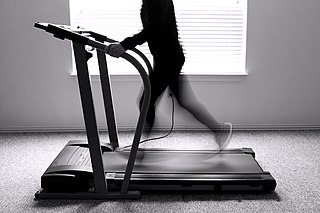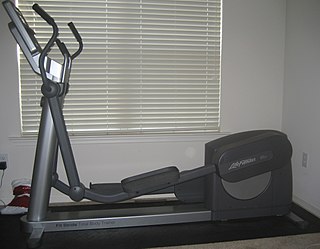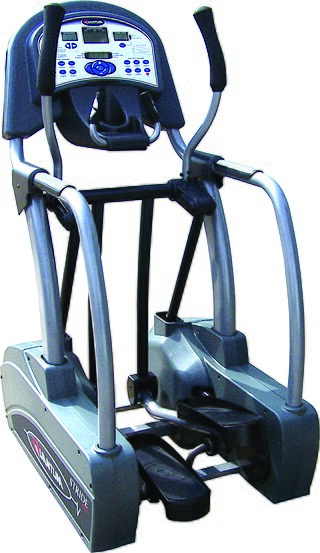
Assistive technology (AT) is a term for assistive, adaptive, and rehabilitative devices for people with disabilities and the elderly. Disabled people often have difficulty performing activities of daily living (ADLs) independently, or even with assistance. ADLs are self-care activities that include toileting, mobility (ambulation), eating, bathing, dressing, grooming, and personal device care. Assistive technology can ameliorate the effects of disabilities that limit the ability to perform ADLs. Assistive technology promotes greater independence by enabling people to perform tasks they were formerly unable to accomplish, or had great difficulty accomplishing, by providing enhancements to, or changing methods of interacting with, the technology needed to accomplish such tasks. For example, wheelchairs provide independent mobility for those who cannot walk, while assistive eating devices can enable people who cannot feed themselves to do so. Due to assistive technology, disabled people have an opportunity of a more positive and easygoing lifestyle, with an increase in "social participation," "security and control," and a greater chance to "reduce institutional costs without significantly increasing household expenses." In schools, assistive technology can be critical in allowing students with disabilities access the general education curriculum. Students who experience challenges writing or keyboarding, for example, can use voice recognition software instead. Assistive technologies assist people who are recovering from strokes and people who have abstained injuries that effect their daily tasks.

In medicine, a prosthesis, or a prosthetic implant, is an artificial device that replaces a missing body part, which may be lost through trauma, disease, or a condition present at birth. Prostheses are intended to restore the normal functions of the missing body part. Amputee rehabilitation is primarily coordinated by a physiatrist as part of an inter-disciplinary team consisting of physiatrists, prosthetists, nurses, physical therapists, and occupational therapists. Prostheses can be created by hand or with computer-aided design (CAD), a software interface that helps creators design and analyze the creation with computer-generated 2-D and 3-D graphics as well as analysis and optimization tools.

Anti-gravity is a hypothetical phenomenon of creating a place or object that is free from the force of gravity. It does not refer to the lack of weight under gravity experienced in free fall or orbit, or to balancing the force of gravity with some other force, such as electromagnetism or aerodynamic lift. Anti-gravity is a recurring concept in science fiction. Examples are the gravity blocking substance "Cavorite" in H. G. Wells's The First Men in the Moon and the Spindizzy machines in James Blish's Cities in Flight.

A treadmill is a device generally used for walking, running, or climbing while staying in the same place. Treadmills were introduced before the development of powered machines to harness the power of animals or humans to do work, often a type of mill operated by a person or animal treading the steps of a treadwheel to grind grain. In later times, treadmills were used as punishment devices for people sentenced to hard labour in prisons. The terms treadmill and treadwheel were used interchangeably for the power and punishment mechanisms.

An elliptical trainer or cross-trainer is a stationary exercise machine used to stair climb, walk, or run without causing excessive pressure to the joints, hence decreasing the risk of impact injuries. For this reason, people with some injuries can use an elliptical to stay fit, as the low impact affects them little. Elliptical trainers offer a non-impact cardiovascular workout that can vary from light to high intensity based on the speed of the exercise and the resistance preference set by the user.

An isometric exercise is a form of exercise involving the static contraction of a muscle without any visible movement in the angle of the joint. The term "isometric" combines the Greek words isos (equal) and -metria (measuring), meaning that in these exercises the length of the muscle and the angle of the joint do not change, though contraction strength may be varied. This is in contrast to isotonic contractions, in which the contraction strength does not change, though the muscle length and joint angle do.

An exercise machine is any machine used for physical exercise. These range from simple spring-like devices to computerized electromechanical devices to recirculating-stream swimming pools. Most exercise machines incorporate an ergometer. An ergometer is an apparatus for measuring the work a person exerts while exercising as used in training or cardiac stress tests or other medical tests.

The following outline is provided as an overview of and topical guide to exercise:
Gait training or gait rehabilitation is the act of learning how to walk, either as a child, or, more frequently, after sustaining an injury or disability. Normal human gait is a complex process, which happens due to co-ordinated movements of the whole of the body, requiring the whole of Central Nervous System - the brain and spinal cord, to function properly. Any disease process affecting the brain, spinal cord, peripheral nerves emerging from them supplying the muscles, or the muscles itself can cause deviations of gait. The process of relearning how to walk is generally facilitated by Physiatrists or Rehabilitation medicine (PM&R) consultants, physical therapists or physiotherapists, along with occupational therapists and other allied specialists. The most common cause for gait impairment is due to an injury of one or both legs. Gait training is not simply re-educating a patient on how to walk, but also includes an initial assessment of their gait cycle - Gait analysis, creation of a plan to address the problem, as well as teaching the patient on how to walk on different surfaces. Assistive devices and splints (orthosis) are often used in gait training, especially with those who have had surgery or an injury on their legs, but also with those who have balance or strength impairments as well.
Aquatic therapy refers to treatments and exercises performed in water for relaxation, fitness, physical rehabilitation, and other therapeutic benefit. Typically a qualified aquatic therapist gives constant attendance to a person receiving treatment in a heated therapy pool. Aquatic therapy techniques include Ai Chi, Aqua Running, Bad Ragaz Ring Method, Burdenko Method, Halliwick, Watsu, and other aquatic bodywork forms. Therapeutic applications include neurological disorders, spine pain, musculoskeletal pain, postoperative orthopedic rehabilitation, pediatric disabilities, and pressure ulcers.

Weightlessness is the complete or near-complete absence of the sensation of weight. It is also termed zero gravity, zero G-force, or zero-G. Micro-g environment is more or less synonymous, with the recognition that g-forces are never exactly zero.
Össur hf. is a company based in Iceland that develops, manufactures and sells non-invasive equipment for orthopaedics, including bracing and support products, compression therapy, and prosthetics. The company is headquartered in Reykjavík, with offices in the Americas, Europe, and Asia, and distributors in other markets.

The Arc Trainer is a stationary, non-impact exercise machine, and is a registered trademark of Cybex International, Inc. The Arc Trainer is manufactured in Owatonna, MN.

A powered exoskeleton, also known as power armor, powered armor, powered suit, cybernetic suit, cybernetic armor, exosuit, hardsuit, exoframe or augmented mobility, is a mobile machine that is wearable over all or part of the human body, providing ergonomic structural support and powered by a system of electric motors, pneumatics, levers, hydraulics or a combination of cybernetic technologies, while allowing for sufficient limb movement with increased strength and endurance. The exoskeleton is designed to provide better mechanical load tolerance, and its control system aims to sense and synchronize with the user's intended motion and relay the signal to motors which manage the gears. The exoskeleton also protects the user's shoulder, waist, back and thigh against overload, and stabilizes movements when lifting and holding heavy items.
A gait trainer is a wheeled device that assists a person who is unable to walk independently to learn or relearn to walk safely and efficiently as part of gait training. Gait trainers are intended for children or adults with physical disabilities, to provide the opportunity to improve walking ability. A gait trainer offers both unweighting support and postural alignment to enable gait practice. It functions as a support walker and provides more assistance for balance and weight-bearing, than does a traditional rollator walker, or a walker with platform attachments. It also provides opportunities to stand and to bear weight in a safe, supported position.

Ekso Bionics Holdings Inc. is a company that develops and manufactures powered exoskeleton bionic devices that can be strapped on as wearable robots to enhance the strength, mobility, and endurance of industrial workers and people experiencing paralysis and mobility issues after a brain injury, stroke, multiple sclerosis (MS) or spinal cord injury. They enable individuals with any amount of lower extremity weakness, including those who are paralyzed, to stand up and walk.
When treating a person with a spinal cord injury, repairing the damage created by injury is the ultimate goal. By using a variety of treatments, greater improvements are achieved, and, therefore, treatment should not be limited to one method. Furthermore, increasing activity will increase his/her chances of recovery.

Rebound exercise is a type of elastically leveraged low-impact exercise usually performed on a device known as a rebounder—sometimes called a "mini-trampoline" or "fitness trampoline"—which is directly descended from regular sports or athletic trampolines.

Locomotion in space includes all actions or methods used to move one's body in microgravity conditions through the outer space environment. Locomotion in these conditions is different from locomotion in a gravitational field. There are many factors that contribute to these differences, and they are crucial when researching long-term survival of humans in space.

The ROVR is an omnidirectional treadmill that simulates walking and running in virtual reality when used alongside a head-mounted display.















